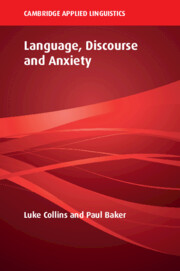Book contents
- Language, Discourse and Anxiety
- THE CAMBRIDGE APPLIED LINGUISTICS SERIES
- Language, Discourse and Anxiety
- Copyright page
- Contents
- Figures
- Tables
- Acknowledgements
- Preface
- 1 Anxiety, Online Fora and This Study
- 2 Sketching Anxiety
- 3 The Lived Experience
- 4 Creating a Community
- 5 Sex and Gender
- 6 Comparing Cultures
- 7 Time
- 8 Conclusion
- References
- Index
2 - Sketching Anxiety
Published online by Cambridge University Press: 08 June 2023
- Language, Discourse and Anxiety
- THE CAMBRIDGE APPLIED LINGUISTICS SERIES
- Language, Discourse and Anxiety
- Copyright page
- Contents
- Figures
- Tables
- Acknowledgements
- Preface
- 1 Anxiety, Online Fora and This Study
- 2 Sketching Anxiety
- 3 The Lived Experience
- 4 Creating a Community
- 5 Sex and Gender
- 6 Comparing Cultures
- 7 Time
- 8 Conclusion
- References
- Index
Summary
Our analysis begins with a focus on the word anxiety, using the corpus analysis tool Sketch Engine to provide a detailed ‘Word Sketch’ of its use in the forum; for example, looking at its occurrence in different grammatical patterns. This analysis identified four clines in terms of how anxiety is discursively constructed: 1) catastrophisation vs minimisation (e.g., some patients refer to having terrible anxiety while others downplay their condition using phrases such as it’s just anxiety); 2) medicalisation vs non-medicalisation (e.g., use of medical terminology such as anxiety disorder vs colloquial expressions such as anxiety crap); 3) personalisation vs impersonalisation (e.g., some posters represent their anxiety as a conscious being with its own wants and grammatical agency, such as anxiety is playing mind games with them, while others represent anxiety as an abstract concept, such as as an illness); and 4) internalisation vs externalisation (e.g., some people claim their anxiety is part of themselves – my anxiety – while others refer to it as something separate – the anxiety monster).
- Type
- Chapter
- Information
- Language, Discourse and Anxiety , pp. 29 - 61Publisher: Cambridge University PressPrint publication year: 2023

